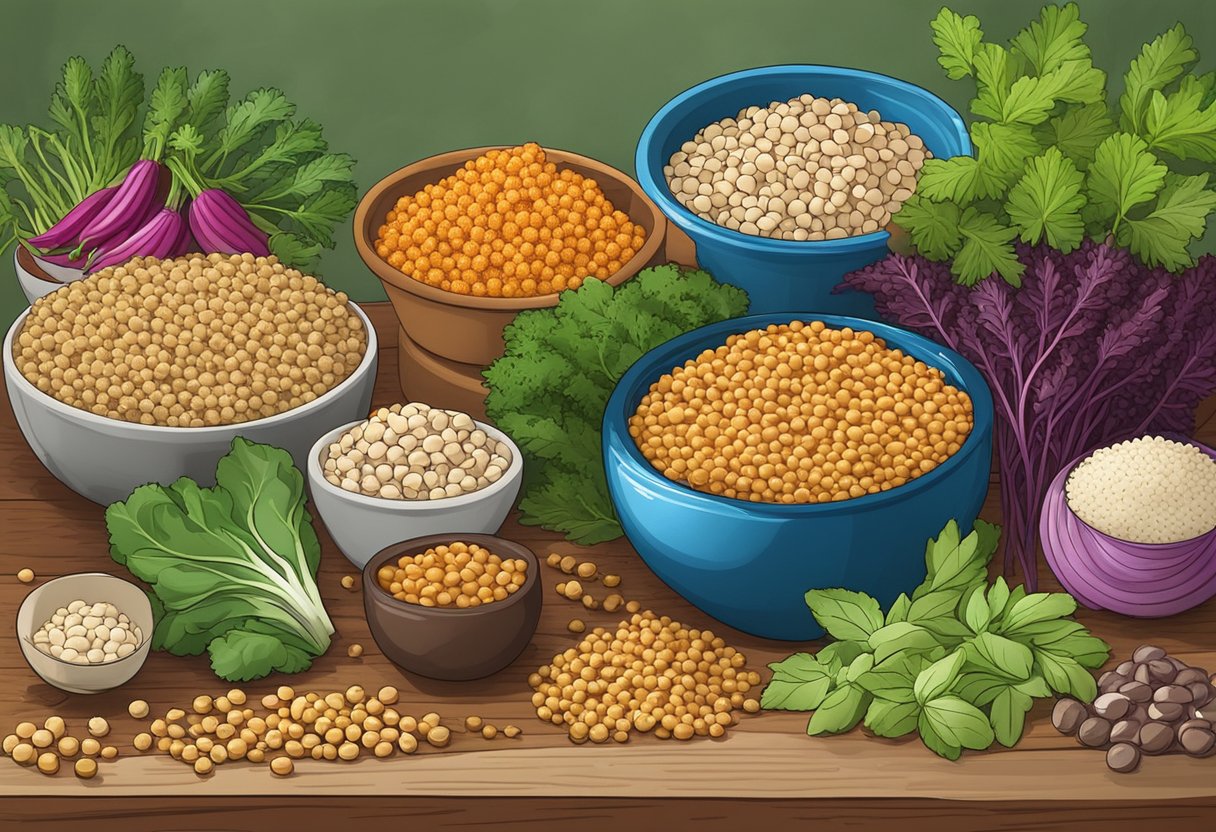Adopting a gluten-free lifestyle can be challenging, particularly when it comes to ensuring you receive enough protein. However, the Mediterranean diet offers a wealth of plant-based, gluten-free proteins that not only satisfy dietary requirements but also provide additional health benefits. The key to incorporating these proteins into your diet is to understand which foods are rich in nutrients, versatile in recipes, and aligned with Mediterranean eating principles.

The Mediterranean diet emphasizes the consumption of fruits, vegetables, whole grains, legumes, and nuts, many of which are naturally gluten-free. Plant-based proteins such as lentils, chickpeas, quinoa, and seeds are integral to this diet and are excellent alternatives to traditional gluten-containing grains. By embracing the array of gluten-free options available within this diet, individuals can enjoy a diverse and nutritionally complete meal plan that supports overall health and well-being.
Key Takeaways
- Plant-based proteins are central to a gluten-free Mediterranean diet, offering a diverse array of nutrient-rich options.
- Understanding gluten-free alternatives is essential for maintaining a balanced and healthful Mediterranean meal plan.
- The Mediterranean diet’s focus on wholesome, plant-based foods aligns with dietary needs for those avoiding gluten.
Table of Contents
Understanding Gluten-Free Diets

A gluten-free diet eliminates all foods containing gluten, a protein found in wheat, barley, and rye. This diet is essential for individuals with Celiac Disease, an autoimmune disorder where gluten intake leads to intestinal damage. Adhering to a gluten-free lifestyle is also chosen by some looking to improve digestive health or mitigate symptoms associated with various conditions, such as diabetes and heart disease.
Gluten-free diets necessitate careful selection of grains to maintain adequate nutrient and fiber intake. Gluten-free whole grains like oats, rice, buckwheat, and corn can be seamlessly integrated into a Mediterranean diet pattern, providing both nutrition and variety.
| Gluten-Free Whole Grains | Nutrient Profile |
|---|---|
| Oats | Rich in fiber, can lower cholesterol when gluten-free. |
| Rice | Diverse varieties provide vitamins and minerals. |
| Buckwheat | Contains essential amino acids, fiber, and is high in protein. |
| Corn | Offers fiber, vitamins B and C, and is a staple in many cultures. |
Ensuring a balanced gluten-free diet may help manage weight and prevent long-term health issues such as certain cancer risks. A well-planned diet includes a variety of natural gluten-free foods to avoid deficiencies while also considering the cultural connection of food.
There is a meaningful connection between a gluten-free diet and the promotion of health, especially when combined with the stress on whole, unprocessed foods within the Mediterranean paradigm. These elements together support well-being while honoring flavorful and diverse culinary traditions.
Fundamentals of the Mediterranean Diet

The Mediterranean Diet emphasizes a balanced approach to eating with a focus on plant-based foods, complemented by a variety of other whole foods, while limiting the intake of processed options and red meats. This dietary pattern has been widely studied and praised for its association with numerous health benefits.
Key Components
- Vegetables: A staple in every meal, providing essential nutrients and fiber.
- Fruits: Consumed regularly as desserts or snacks.
- Nuts and Seeds: Included for their healthy fat content and as a source of protein.
- Legumes: Beans and pulses are integral for protein and fiber.
- Whole Grains: Often found in bread and pasta, selected whole grains can be gluten-free.
- Healthy Fats: Predominantly from olive oil, which is used in cooking and dressings.
- Fish: Especially fatty fish, is consumed regularly for its omega-3 fatty acids.
- Dairy: Mainly as cheese and yogurt, in moderate portions.
- Eggs and Poultry: Eaten in moderation, these provide additional protein options.
- Red Meat: Limited to a few times per month.
Health Benefits
The Mediterranean diet has been associated with:
| Health Benefits | Description |
|---|---|
| Cardiovascular Health | Repeatedly linked to a lower risk of heart disease and stroke. |
| Metabolic Health | May improve glucose control, aiding in the management of diabetes and weight. |
| Reduced Inflammation | Its anti-inflammatory properties can potentially reduce risks of certain cancers. |
| Healthy Aging | Linked to a slower aging process and may lead to a longer lifespan. |
Dietary Patterns
- Focus on plant-based foods: Vegetarian and vegan options are abundant within the diet.
- Inclusion of animal products: When consumed, they are in smaller quantities.
- Regular exercise: Paired with the Mediterranean diet for a holistic approach to health.
- Meal planning: Often advised by a registered dietitian to ensure nutritional needs are met, especially when adhering to a gluten-free regimen.
- Moderate alcohol consumption: Particularly wine, is typically enjoyed with meals. Sweets are reserved for occasional treats rather than daily indulgences.
Gluten-Free Proteins in a Mediterranean Diet
Adopting a gluten-free Mediterranean diet involves focusing on naturally gluten-free proteins, including a variety of plant-based sources and nutrient-rich animal proteins like seafood and poultry.
Plant-Based Protein Sources
Proteins are essential for the body’s growth and repair, and a Mediterranean diet caters to this need with a variety of gluten-free, plant-based proteins. Common sources include:
- Lentils: A versatile ingredient in soups and salads, lentils provide about 18 grams of protein per cooked cup.
- Chickpeas: With 15 grams per cooked cup, chickpeas can be used in hummus or as a fiber-rich addition to meals.
- Quinoa: A pseudo-grain that serves as a complete protein, containing approximately 8 grams per cooked cup.
- Nuts like almonds: Snack on a handful of almonds, which offer 6 grams of protein per ounce, or use them in recipes.
- Seeds: Chia, flax, and pumpkin seeds are excellent sprinkled on dishes for an extra boost of protein.
- Vegetables: Incorporate spinach, broccoli, and kale into your diet; they’re not only rich in protein but also packed with other nutrients.
Edamame:
These young soybeans deliver about 17 grams of protein per cup and fit perfectly into the Mediterranean palette as a fresh appetizer or a side dish.
Incorporating Seafood and Poultry
The Mediterranean diet is known for its moderate use of animal proteins, especially:
- Fish: Options like salmon and tuna are important for their high protein content and omega-3 fatty acids.
- Shrimp: Another excellent gluten-free protein option, providing roughly 20 grams per 3-ounce serving.
Chicken tends to be a staple in the diet, offering another high-protein, gluten-free choice that can be prepared in countless healthy ways to match Mediterranean flavors.
Creating a Balanced Gluten-Free Mediterranean Meal Plan

Crafting a balanced meal plan for a gluten-free Mediterranean diet involves incorporating a variety of nutrient-rich foods. The focus is on gluten-free whole grains, fresh vegetables, fruits, legumes, nuts, seeds, and the use of flavorful herbs and spices to create nutritious and delicious meals.
Sample Meal Ideas
Breakfast: Quinoa porridge topped with sliced almonds and fresh berries.
- Gluten-Free Whole Grains: Quinoa
- Nuts: Almonds
- Fruits: Berries
Lunch: Mixed greens salad with chickpeas, peppers, Kalamata olives, and a lemon-oregano dressing.
- Vegetables: Mixed Greens, Peppers
- Legumes: Chickpeas
- Fruits: Lemon
- Herbs: Oregano
Dinner: Grilled vegetable skewers with a side of herb-seasoned buckwheat.
- Gluten-Free Whole Grains: Buckwheat
- Vegetables: Assorted vegetables for skewers
Snacks: Rice cakes with a white bean spread and a sprinkle of spices.
- Gluten-Free Whole Grains: Rice
- Legumes: White Bean
- Spices: Variety based on preference
The aim is to ensure that each meal is a blend of fiber, omega-3, healthy fats, and other essential nutrients, while also ensuring the exclusion of gluten.
Nutritionist-Approved Strategies
A registered dietitian advises that a balanced gluten-free Mediterranean meal plan should have:
- Ample Fiber: Choose gluten-free whole grains like quinoa, rice, and buckwheat to add to meals.
- Omega-3 and Healthy Fats: Incorporate nuts and seeds for their omega-3 fatty acids and healthy fats.
- Diverse Nutrients: Add a colorful array of vegetables to each meal for a wide range of nutrients.
- Hydration: Emphasize the intake of water throughout the day.
When planning meals, they suggest calculating nutrient intake to ensure a well-rounded diet. Additionally, experimenting with herbs and spices like oregano adds robust flavor without the need for excess salt or fat.
Considerations for Special Health Needs

A gluten-free Mediterranean diet integrates nutritional awareness with specific health considerations, focusing on plant-based proteins, which are crucial for those managing particular health conditions.
Managing Weight and Metabolism
Weight management is a significant concern for individuals with Type 2 Diabetes or heart disease, where diet plays a pivotal role. Plant-based proteins in a gluten-free Mediterranean diet provide a balanced approach to sustenance without the added risks associated with red and processed meats. For example, legumes, such as lentils, are not only high in protein but also aid in metabolism and weight control.
Addressing Autoimmune and Inflammatory Conditions
Those diagnosed with Celiac Disease must avoid gluten to prevent harmful inflammation and manage their condition effectively. Incorporating gluten-free sources of protein found abundantly in the Mediterranean diet can help minimize the autoimmune response. The natural anti-inflammatory properties of plant-based foods can also alleviate symptoms. For instance, the Mediterranean diet is rich in fruits and vegetables, which are known to reduce inflammation and provide antioxidant benefits, thus supporting those with Celiac Disease and other autoimmune diseases.
Culinary Techniques and Ingredient Substitutions
Adapting to a Mediterranean diet free of gluten involves knowing the basics of gluten-free cooking and learning about alternative ingredients that do not compromise on taste or nutrition.
Gluten-Free Cooking Basics
Essential to gluten-free Mediterranean cuisine are cooking techniques that prevent cross-contamination. Kitchen equipment used for gluten-containing foods should be thoroughly cleaned before preparing gluten-free meals. Additionally, naturally gluten-free whole grains like rice, buckwheat, and corn can be used as staple ingredients. When considering flour alternatives for baking and thickening, one can opt for gluten-free flour blends designed to mimic the properties of wheat flour.
Alternatives to Common Gluten-Containing Foods
Finding alternatives for traditional gluten-containing ingredients is crucial in a gluten-free Mediterranean diet. Below is a list highlighting acceptable substitutions:
- Pasta: Choose pasta made from gluten-free whole grains such as rice, corn, or buckwheat.
- Breads and Crackers: Look for options made with gluten-free grains and flour such as oats that are certified gluten-free.
- Couscous: Replace with quinoa, which has a similar texture and is naturally gluten-free.
- Protein Sources: Incorporate a variety of legumes, nuts, and seeds. Soy products like tofu can also be excellent protein-rich options.
- Dairy Alternatives: Instead of traditional cheeses, opt for feta cheese made from sheep’s milk or plant-based cheese; use plain Greek yogurt or nut-based products to replace yogurt.
By implementing these culinary techniques and ingredient substitutions, one can enjoy the full spectrum of Mediterranean flavors while adhering to a gluten-free lifestyle.
Lifestyle and Dietary Tips

Adopting a gluten-free Mediterranean diet focusing on plant-based proteins can be a transformative approach to improving one’s general wellness. This section delves into practical strategies for integrating exercise with diet and fostering a community for sustained lifestyle change.
Integrating Exercise and Diet
Regular exercise is a cornerstone of a healthy lifestyle, and it complements the Mediterranean diet’s heart-protective qualities. A mix of aerobic activities, like brisk walking or swimming, and resistance training supports cardiovascular health and can reduce the risk of heart disease and stroke. Adults should aim for at least 150 minutes of moderate-intensity exercise weekly, which not only counteracts the effects of aging but also synergizes with a diet rich in plant-based proteins to enhance overall health.
Building a Supportive Community
Creating a dietary support system with family, friends, or a registered dietitian is crucial when transitioning to a gluten-free Mediterranean diet. A dietitian can tailor a dietary plan to fit individual needs, ensuring adequate nutrient intake and setting realistic goals. Meanwhile, sharing meals with others who appreciate or follow a similar diet reinforces adherence to this healthy eating pattern and fosters a sense of camaraderie that can make the journey more enjoyable and sustainable.
Accessing Resources and Professional Guidance

When adopting a gluten-free Mediterranean diet, individuals often seek expertise to ensure their nutritional needs are met, particularly when managing health conditions like Celiac Disease, Heart Disease, or Diabetes. Registered Dietitians are key professionals in providing tailored guidance. They can assess individual dietary needs and suggest appropriate plant-based proteins that align with the diet’s principles.
For Celiac Disease:
- Ensuring a diet free from gluten while maintaining a balanced intake of nutrients is vital.
- A Dietitian can help identify gluten-free grains like quinoa and recommend fortified foods to prevent nutrient deficiencies.
For Heart Disease:
- The Mediterranean diet’s emphasis on plant-based foods can offer heart-healthy benefits.
- Dietitians may focus on integrating high-fiber legumes and nuts, which are naturally gluten-free and beneficial for cardiovascular health.
For Diabetes:
- Balancing carbohydrates and maintaining low Glycemic Index (GI) food intake is essential.
- Consulting with a Dietitian can lead to personalized meal plans that incorporate suitable gluten-free options like lentils and chickpeas, which are also rich in protein.
Patients can find dietetic professionals through local hospitals, clinics, or private practices. Additionally, reputable organizations such as the Celiac Disease Foundation offer resources and guidance on gluten-free dietary patterns, including those within a Mediterranean framework.
Transitioning to a specific diet, particularly for individuals with certain medical conditions, should not be approached lightly. Therefore, the support and advice of a healthcare provider are important cornerstones to ensure the path to dietary change is both safe and effective.
Frequently Asked Questions
In this section, we address common inquiries about incorporating gluten-free plant-based proteins into the Mediterranean diet, offering practical advice for meal planning and recipe resources.
What plant-based proteins are recommended for a gluten-free Mediterranean diet?
Individuals following a gluten-free Mediterranean diet often include plant-based proteins like legumes—beans, lentils, and chickpeas—which are naturally gluten-free. Nuts and seeds, such as almonds and chia seeds, also serve as excellent sources of protein and other nutrients.
How can I plan a gluten-free Mediterranean diet meal?
Planning a gluten-free Mediterranean meal involves focusing on fresh vegetables, fruits, gluten-free whole grains like quinoa, and incorporating plant-based proteins. Meals should be balanced with a healthy dose of olive oil and perhaps some fish or seafood for non-plant-based proteins. For guidance, the Celiac Disease Foundation provides a structured meal plan.
What should be included in a gluten-free Mediterranean diet shopping list?
A well-prepared shopping list should include various fresh vegetables, fruits, gluten-free whole grains, legumes, nuts, seeds, and extra virgin olive oil. Dairy, like Greek yogurt and cheeses, should be included in moderation. Always check labels to ensure that products are certified gluten-free.
Where can I find gluten-free Mediterranean diet recipes?
A variety of gluten-free Mediterranean diet recipes can be found on online platforms such as the Beth Israel Deaconess Medical Center’s website, which offers dietary advice and sample meals for individuals managing celiac disease.
Is it possible to find a Mediterranean diet cookbook that is gluten-free friendly?
Yes, cookbooks that combine the principles of the Mediterranean diet with gluten-free living are available. These books help those with gluten sensitivities to enjoy the full flavor and health benefits of Mediterranean cuisine without the worry of gluten content.
What are some gluten-free breakfast options suitable for the Mediterranean diet?
For a gluten-free Mediterranean breakfast, one might opt for a cup of cooked gluten-free whole grain like buckwheat, topped with mixed berries and nuts, accompanied by low-fat Greek yogurt. The BIDMC of Boston suggests a variety of gluten-free grains that fit well into a Mediterranean diet plan.



